Cover image caption: A rare picture of Sir Samad at Srinagar with his youngest son Yaqub (on the extreme left) before he joined the Indian Military Academy in 1938. In the center are two ex-prime ministers of Kashmir (L) Hari Kishan Kaul and (R) Colonel KN Haksar.
Many would recognize the name of Sahabzada Yaqub Khan, former general and foreign minister, but they would not be familiar with the name of his father Sahabzada Sir Abdus Samad Khan. He was a gentleman of great stature and a leading administrator in British India during the 1920s and 1930s.
Sir Samad was from the clan of Rohillas that migrated from the Pashto speaking regions during the decline of the Mughal Empire. Between the 17th and 18th centuries, they gained control of a region of western Oudh that came to be known as Rohilkhand. Sir Samad belonged to a very distinguished lineage from Najib Khan, a Yousafzai Pathan who was an ally of Ahmed Shah Durrani. He was commanding a force of Rohillas in the Third Battle of Panipat, which changed the course of Indian history. He founded the State of Najibabad, and in 1973 was granted the title of Najib-ud-Daula by Mughal Emperor Ahmed Khan.

Dinner during the Second Round Table Conference in 1931. Sir Samad is near the far end of the table on the right.
Nawab Jalaluddin Khan was the last ruler of Najibabad and allegedly supported Mughal Emperor Bahadur Shah Zafar during the revolt of 1857. Nawab Jalaluddin Khan and his brother-in-law Nawab Sa'adullah Khan were both executed after a court-martial and their lands seized, although they were innocent of any complicity in the uprising. Their families fled Najibabad and were given shelter by their kinsmen and rulers of Rampur.
Nawab Sa’adullah’s son was Nawab Abdussalam Khan, father of Sir Samad. Nawab Salam was a bibliophile and amassed a large library of books. Like many Indian Muslims of that period, he was a great admirer of Turkey and was always attired in a tunic and a fez. Sir Samad was born in 1874 in Moradabad and educated in Lucknow.
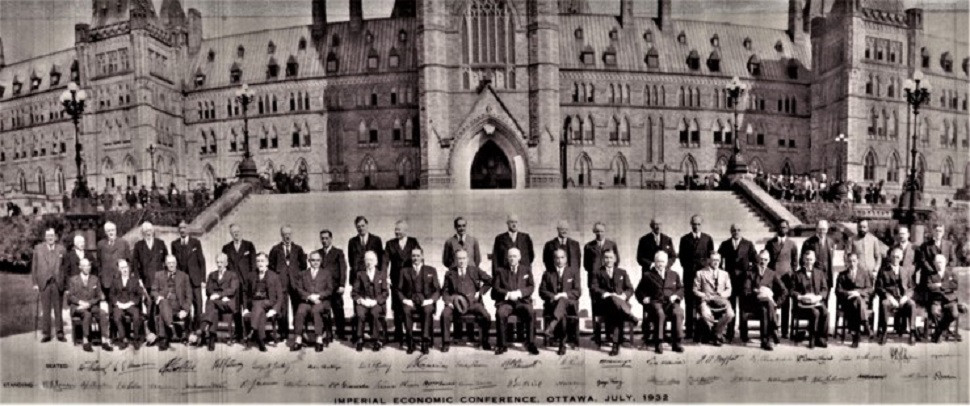
Members of the Imperial Economic Conference at Ottawa 1932. Sir Samad is standing fifth from the left.
At the age of 13, Nawab Hamid Ali Khan ascended the throne of Rampur under a regent appointed by the British. The vice president of the Rampur Regency Council was General Azimuddin Khan, son of Nawab Jalaluddin and a first cousin to Sir Samad’s father. He had joined the Rampur State Forces; he was a very capable officer and had risen to be the sipha salar (C-in-C).
General Azimuddin was in charge of his ward’s education. Since the nawab and Abdus Samad were of the same age, the two boys were educated together at Rampur in Arabic, English, Urdu, and Persian by tutors who demanded a high standard from their students. Samad’s English tutor called him MacDuff, and it became his nickname. In the meantime, his brother Abdul Wahid Khan read Law at Oxford, was admitted to the Bar from Lincoln's Inn, and retired as a judge. At Oxford, Wahid was befriended by M A Jauhar, who became a journalist and was a prominent member of the Muslim League. He was also among the leading figures of the Khilafat Movement.
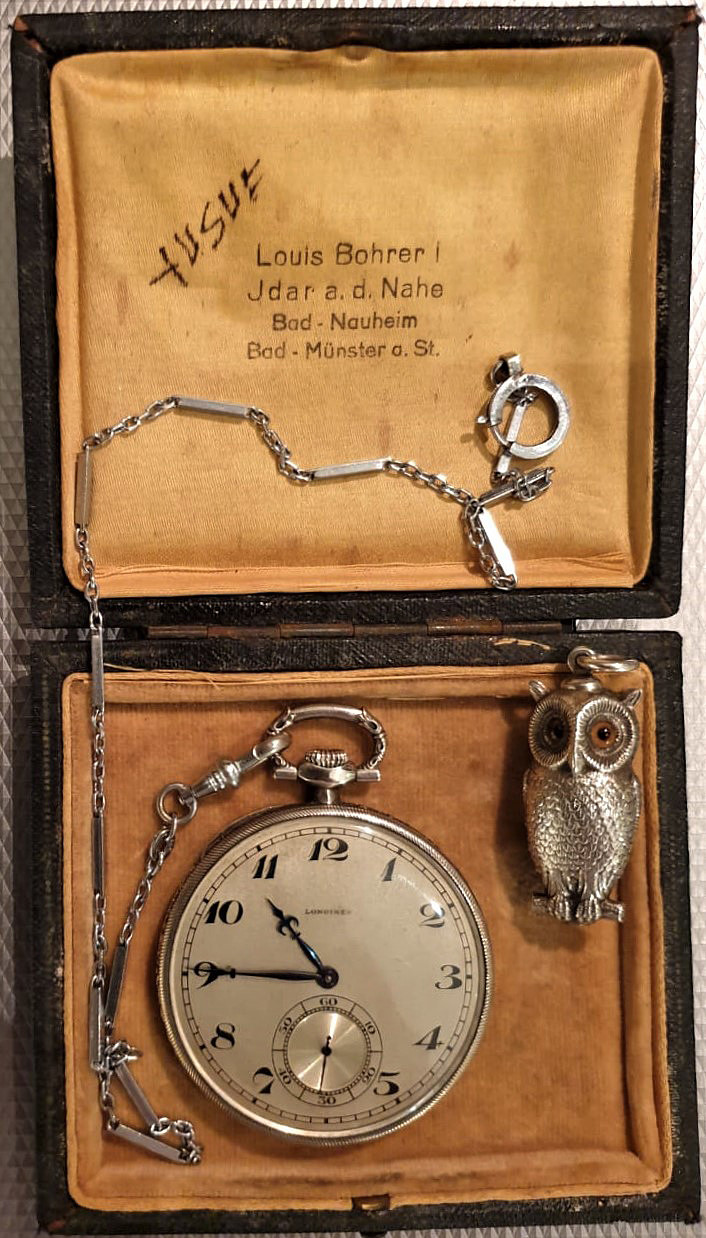
A Longines dress watch was purchased by Sir Samad at Munster, Germany in 1935 and presented to his son Yusuf. The owl has a lead pencil to jot down brief notes at a meeting.
General Azimuddin was a reformer and a good administrator, but the orthodox Rohilla nobles detested him because he restricted their massive loans, many of which were unpaid. As a result of court intrigues, he was murdered in 1891 when he was only 37 years old. Shortly after, the 21-year-old Nawab Hamid was invested with complete ruling powers, and he appointed Sir Samad as his Private Secretary. In 1900, at the age of 26, Sir Samad was elevated to the post of Chief Minister, which he continued to hold for thirty years.
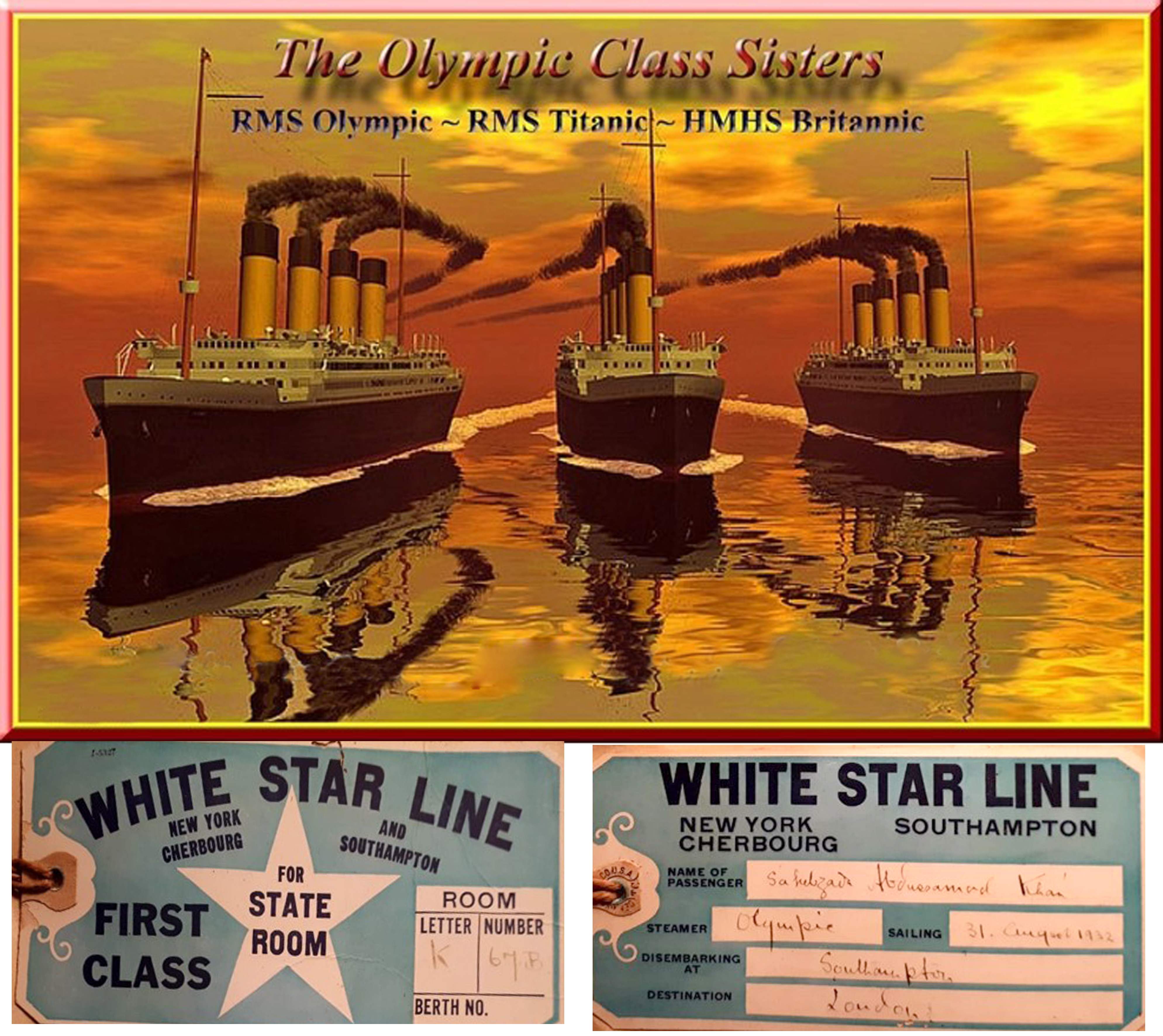
RMS Olympic (Left) on which Sir Samad sailed from New York to Southampton with its sister ships – Titanic & Britannic. His baggage tags are below.
In 1907, Sir Samad constructed a double-story mansion in Rampur whose architecture was a fusion of western and eastern styles. As per the traditions followed in that era, the mansion had male and female quarters with their own courtyards, verandas, and bedrooms. In her autobiography, his daughter Jahanara recollects that it was a full house with her grandmother along with her entourage and other relatives with their children, and there were servants everywhere. The mansion had an extensive estate with lawns and flower beds, a mango grove, a mosque, stables, a ghat (washing pit) for the dhobi (washer man), and servant quarters. Sir Samad had a rose garden prepared in front of his bedroom window, and because he loved the flower so much, the house came to be called Rosaville.
The two big events that occurred during the early 1900s were the Delhi Durbars of 1903 and 1911. The 1903 durbar was held to celebrate the succession of Edward VII as Emperor of India, while the 1911 Durbar was held to celebrate the coronation of King George V and Queen Mary. Both the events were a dazzling display of pomp and power and were attended by practically every ruling prince and nobleman of India, plus thousands of landed gentry and notables. All those who participated were awarded medals. Sir Samad was awarded the Delhi Durbar silver medals for both 1903 and 1911 durbars.
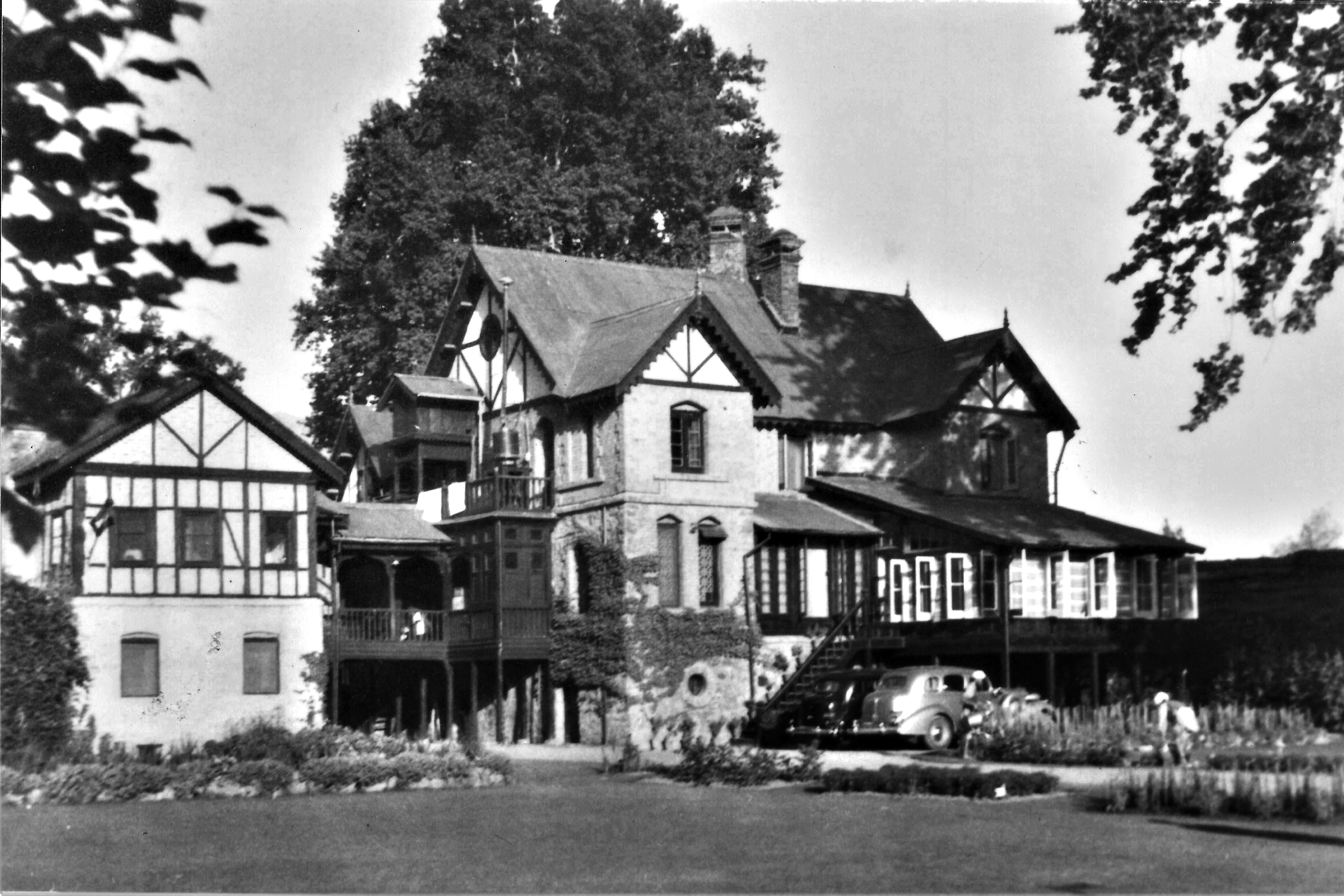
Sir Samad’s residence in Srinagar while he was home minister 1937-41.
Abdus Samad’s first marriage was to the daughter of General Azimuddin but she passed away at a young age. His second marriage was in 1914 in Delhi to Aliya Sultan Begum, the niece of the Nawab of Loharu. Aliya Begum had links to the family of the famous poet Mirza Ghalib.
In 1915, the Sultan of Turkey conferred on Sir Samad the Order of Osmanieh, but since the two empires were at war, the British Government had reservations and instead, appointed him as the Companion of the Indian Empire in late 1915. Sir Samad ensured that during the First World War the State of Rampur, like others, contributed to the war effort by generously donating to the Imperial Indian Relief Fund, and to the scheme for a hospital ship. A contingent of the Rampur Indian Service Infantry fought in the East African Campaign.
In 1929, Sir Samad’s father passed away, and Sir Ross Masood, the grandson of Sir Syed and vice chancellor of the Aligarh University, accepted his collection of books and manuscripts for the Maulana Azad Library of Aligarh Muslim University. Nawab Hamid Ali Khan also passed away the following year and his death must have greatly saddened Sir Samad who had been his lifelong companion. Sir Samad continued as chief minister for the next six years with the son and successor, Nawab Raza Ali. The new nawab was also Sir Samad’s son-in-law as he was married in 1920 to Rafat Zamani, Sir Samad’s daughter from his first marriage.
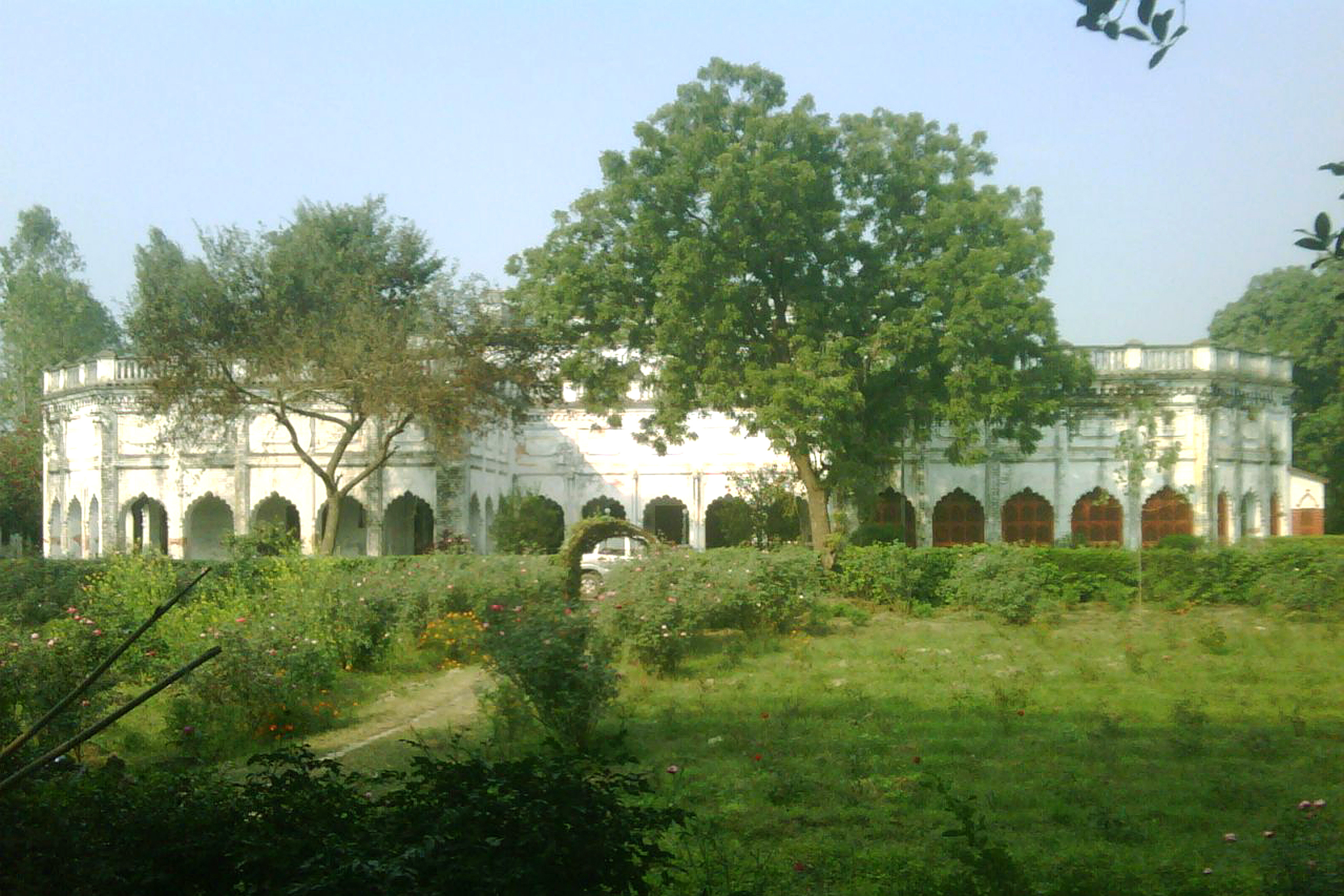
‘Rosavile’ – Sir Samad’s residence in Rampur that was constructed in 1907.
After studying at the University School in Aligarh, Sir Samad’s older sons, Yusuf and Yunus, were admitted into the Colonel Brown’s School at Dehradun. It was one of the oldest residential schools in India, and they passed their O Levels there. Yusuf went on to study at Oxford before he became a professor of Geography at the Aligarh University. Yunus served in the military during the Second World War and was selected by Lord Mountbatten as his ADC. After independence, he was appointed as ADC to the president of India but took early retirement. The third and youngest son, Sahabzada Yaqub, was also at Dehradun, studying at the Prince of Wales Royal Indian Military College, which was a feeder institution for the Indian Military Academy located nearby.
Dehradun is a lush green valley, 1,500 feet above sea level and nestled in the foot of the Himalayas. Fortunately for his sons, around 1931, Sir Samad purchased a fully furnished summer home in Dehradun from an Englishman. It was named “Rose Cottage” and had an orchard and a spacious garden with beds of spring flowers and roses, as well as badminton and tennis courts. There were orchards and gardens scattered around the valley and charming picnic spots everywhere. Sir Samad’s sister also had a house in Dehradun. She was married to Dr Saiduzzafer Khan, one of the founders of the King George Medical College in Lucknow. After his retirement, they settled in “Nasreen”, which was built on the model of a large English country mansion with an aviary, fountains, waterfalls, and beehives.
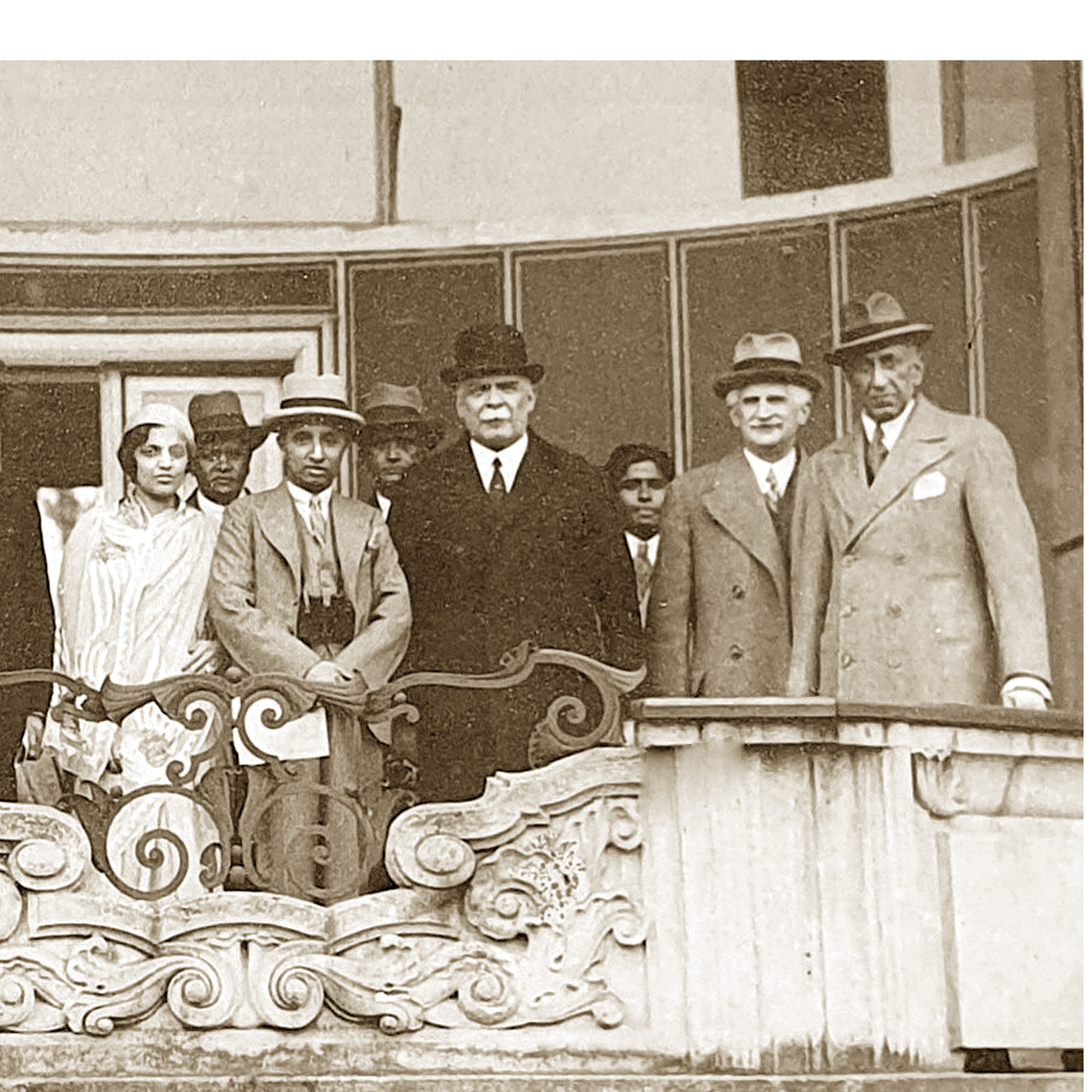
Sir Samad in Vienna with his oldest daughter and son-in-law, Nawab Raza Ali Khan during their tour of Europe in 1935.
At the age of 50, Sir Samad was a striking figure with a tall, slim build and imposing features. During the thirty years that he had served as chief secretary of Rampur, he had matured into a seasoned administrator who executed his duties with utmost care and diligence with no interference by the nawab. He was closely associated with the political department, the governor of the United Province, and the viceroy, and had a large circle of friends, including several rulers of the princely states, particularly the maharajas of Bikaner, Jaipur, and Kashmir, and the nizam of Hyderabad. It was because of these credentials that he was selected to attend three significant events overseas during the early 1930s: Second and Third Round Table Conferences, held in London in 1931 and 1932, the Imperial Economic Conference in Ottawa in 1932, and the Fourteenth Session of the League of Nations in 1933.
The three Round Table Conferences, held between 1930 and 1932, were a series of peace conferences organized by the British Government and Indian political personalities to discuss constitutional reforms in India. The First Round Table Conference was held from November 1930 to January 1931. Prior to the Conference, Mohandas Gandhi had initiated the Civil Disobedience Movement. Since many of the Congress leaders were in jail, the Congress did not participate in the first conference, but representatives from all other Indian parties as well as several princes were in attendance.
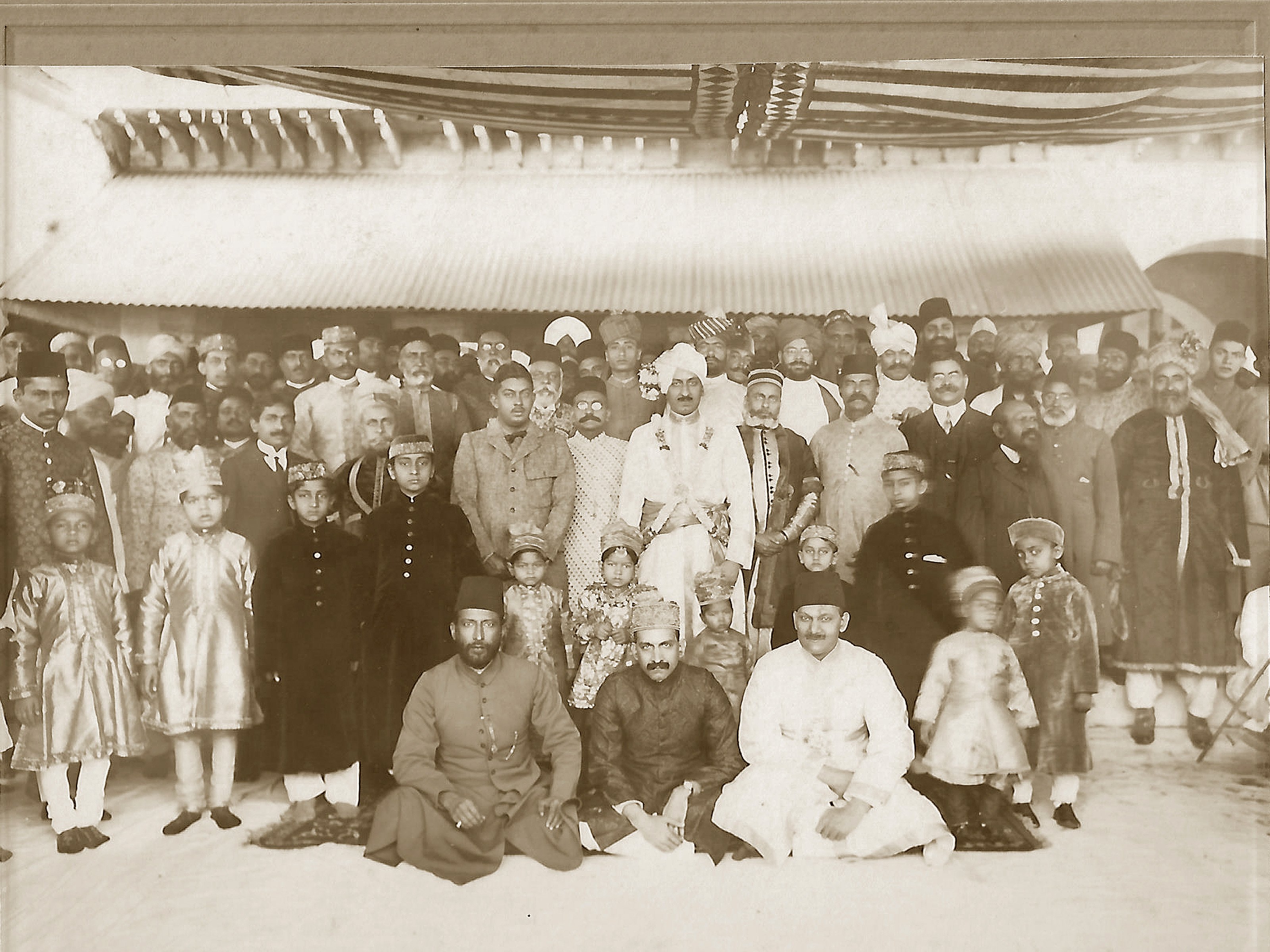
Sir Samad’s second marriage to the niece of the Nawab of Loharu in Delhi was in 1914. On his left is his younger brother Abdul Wahid Khan – Judge and Bar at Law & his brother-in-law Dr. Saiduzzafar Khan.
The Second Round Table Conference was the most important one of the three, with wide participation of a cross-section of Indian politicians, representatives from the princely states, and society in general. It was held in London, from September through November 1931. Sir Samad was a member of the Indian States Delegation Staff and represented the Rampur State. Senior members of the Indian National Congress came in strength, and at the conference, Gandhi claimed to represent all the people of India. However, this view was not shared by other delegates and was one of the reasons why no substantial results were achieved regarding India's constitutional future.
Sir Samad returned to India for six months before he left again to attend the Imperial Economic Conference in Ottawa as a delegate. The conference had its roots in the Great Depression of 1929-32 when the global economy contracted at an alarming rate. The combination of high tariffs and slumping domestic demand sent international trade into a tailspin. Against this backdrop, the leaders of the United Kingdom, the Dominions, and India met in Ottawa during the summer of 1932 to debate the world financial crisis and mitigate its effects through closer imperial economic association.
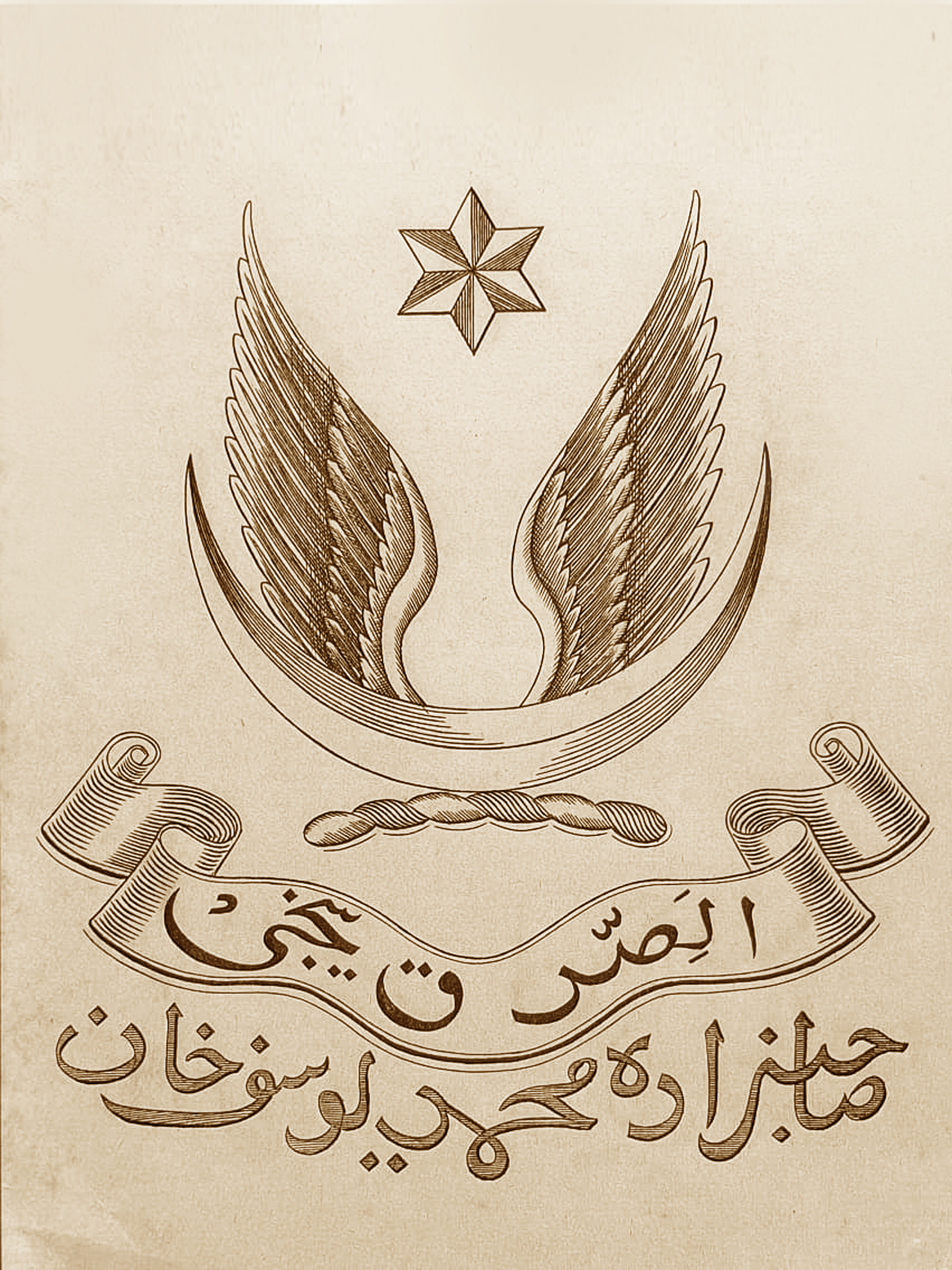
The family crest was inherited by Sir Samad’s son Yousuf who changed the motto to an old Arabic proverb – Truth liberates and falsehood destructs.
India was represented by a delegation of eight headed by Sir Atul Chatterjee, an ICS officer who was twice a member of the governing body of the League of Nations. The two Muslims in the delegation were Sir Samad and the illustrious Seth Haji Abdoola Haroon, the Karachi member of the Central Legislative Assembly. On the way, the delegation spent two months in London to hold discussions with the British Government. The delegation sailed for Canada on 13 July aboard the Empress of Britain, which was the largest, fastest, and most luxurious ship cruising between the UK and Canada.
The conference lasted for six weeks. The first four days of the week were devoted to discussions and meetings while the rest to social activities like formal and informal dinners, gala events, and garden parties. Some ladies had brought maids as well as twenty-thirty pieces of luggage filled with gowns, shoes, and hats to wear at the many events. The family of Haji Sir Abdoola Haroon provided an exotic touch by wearing bright silk saris, embroidered in gold thread.
Underscoring the importance of the conference, British Prime Minister Stanley Baldwin brought half his cabinet, including his Chancellor of the Exchequer Neville Chamberlain who would be the next prime minister. The delegates were formed into committees to discuss pertinent issues, and Sir Samad was the member of the committee on Commercial Relations with Foreign Countries.
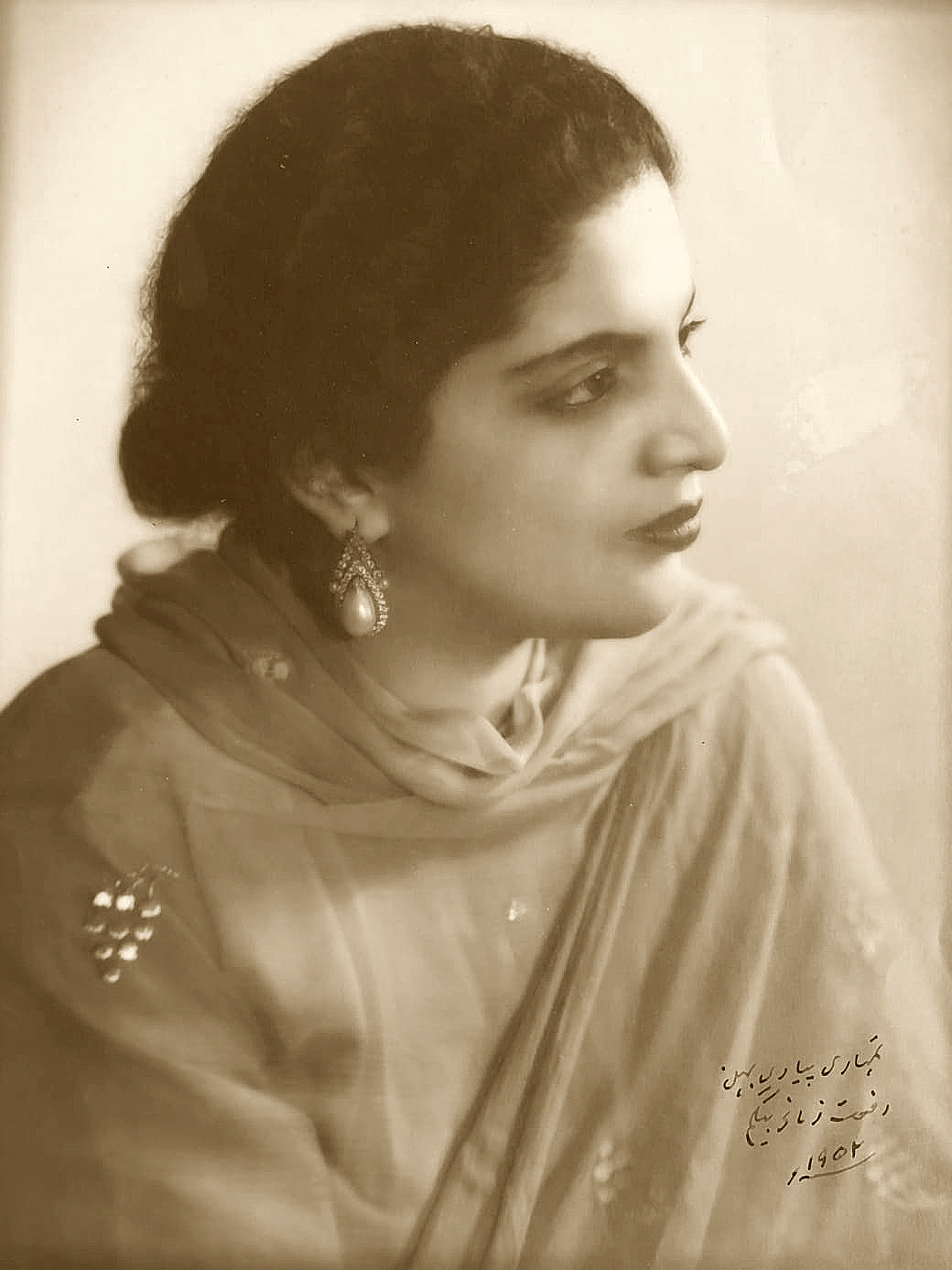
Sir Samad’s eldest daughter HH Rafat Zamani, Begum of Rampur State from 1930 to1949.
On the way back, Sir Samad caught a train to New York, and for the more popular route to Southampton, he travelled first class on the RMS Olympic, which was the sister ship of the Titanic and just as large and luxurious. It was launched a year before the Titanic and was 500 nautical miles away when it received the distress call from its sister ship that subsequently sank. The transatlantic voyage was seven days long, and he arrived in the UK on 7 September after a port call at Cherbourg.
Travelling in style in a luxury liner was not new for Sir Samad. At the age of 18, he had accompanied the Nawab of Rampur on a world cruise that took them to China, Japan, North America, and Europe. It lasted from March till December 1883, and the entourage consisted of three teachers, six secretaries, cooks, and servants, along with a big staff from Thomas Cook, the London-based travel agent.
1655027448-4/ASK-5-(USE-THIS-AS-COVER-IMAGE)1655027448-4.jpg)
Autographed portrait of Sir Samad, taken at the famous Vandyk Studios in London while he was attending the Third Round Table Conference in 1932.
Sir Samad stayed on in London as a guest in the Dorchester Hotel to attend the Third Round Table Conference, which was scheduled from November to December. From when Dorchester opened its doors on Park Lane opposite Hyde Park in April 1931, he had been a regular guest along with his valet Nathu Singh, who was accommodated in the basement that had rooms for the guests’ personal staff. During the 1930s, the hotel became the haunt of numerous writers and artists such as the poet Cecil Day-Lewis, novelists Somerset Maugham and Ernest Hemingway, and the artist Sir Alfred Munnings, one of England’s finest painters of horses. The famous actor and comedian Danny Kay launched his career at the hotel performing in the cabaret.
Like the first conference, the third was also not attended by Gandhi or the Indian National Congress. Many other Indian leaders were also absent, and therefore, little was achieved in way of consensus. The recommendations were debated in the British parliament, and a draft bill was enforced as the Government of India Act of 1935. It tried to give India a constitutional framework but was strongly opposed by all the major parties in India.

Letter by Sir Samad to his brother dated 7 December 1939 on the offer by Sir Ross Masood, VC Aligarh University to include the valuable collection of their father’s books in the university’s Maulana Azad Library.
Six months after attending the last conference, Sir Samad was back this time on the Continent for attending the Fourteenth Session of the League of Nations, the predecessor to the United Nations. It was founded in 1920 with a council of Great Powers and an assembly of member countries that met every year at its headquarters in Geneva till the Second World War. It was conceived by Woodrow Wilson, the American president, but unfortunately, the US legislature voted against joining it.
The League was not representative enough, and there were never more than 65 members. It, therefore, lacked the power to enforce any of the rules that it made and to keep the peace. To increase its voting strength, the British had included its dominions as well as colonial India in the League. Membership in the league enabled India to dispel misperceptions about the "backwardness" of the subcontinent and to show that Indians were fully capable of grappling with complex global issues. After Independence, it also helped in securing status in the international system that gave it a comparative diplomatic advantage over other newly independent countries.
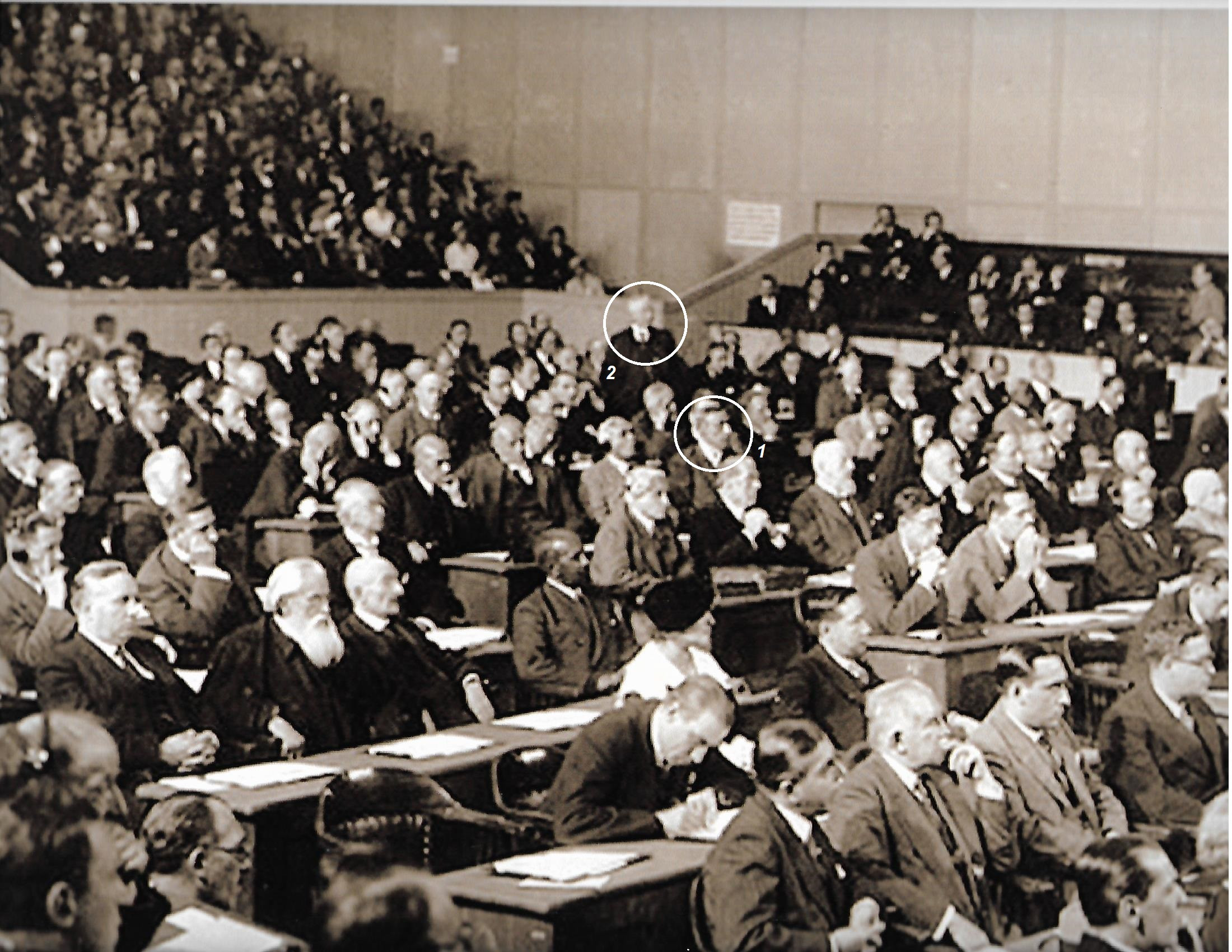
Sir Samad (1) attending the Assembly the League of Nations in Geneva in 1933. Standing behind him is the Agha Khan (2).
However, colonial India had two broad components, i.e., the territories governed by the British administration and 562 princely states. Sir Samad was one of the four Indian delegates and represented the princely states in the Fourteenth Annual Session that was held in the autumn of 1933. Sir Homi Manek Mehta, the great industrialist from Bombay, was also one of the delegates.
When Sir Samad returned to India, he was awarded a knighthood in 1934. He returned to Europe the same year along with Nawab Raza Ali Khan and his begum on their European tour. Before touring the Continent, the entourage had an audience with the king and queen in London. Sir Samad had a fondness for Longines dress watches, which were in vogue in the 1920s and 1930s, and he bought one while visiting Munster, a charming spa resort near Frankfurt. He had it engraved with a family crest that he inherited from his maternal uncle and father-in-law General Azimuddin Khan who had no male issue. It bore a motto in Latin, “Do to others as you expect them to do to you.” However, Sir Samad’s son Yusuf, who inherited the watch and the family crest, changed the motto to an old Arabic proverb: “Truth liberates and falsehood destructs.”
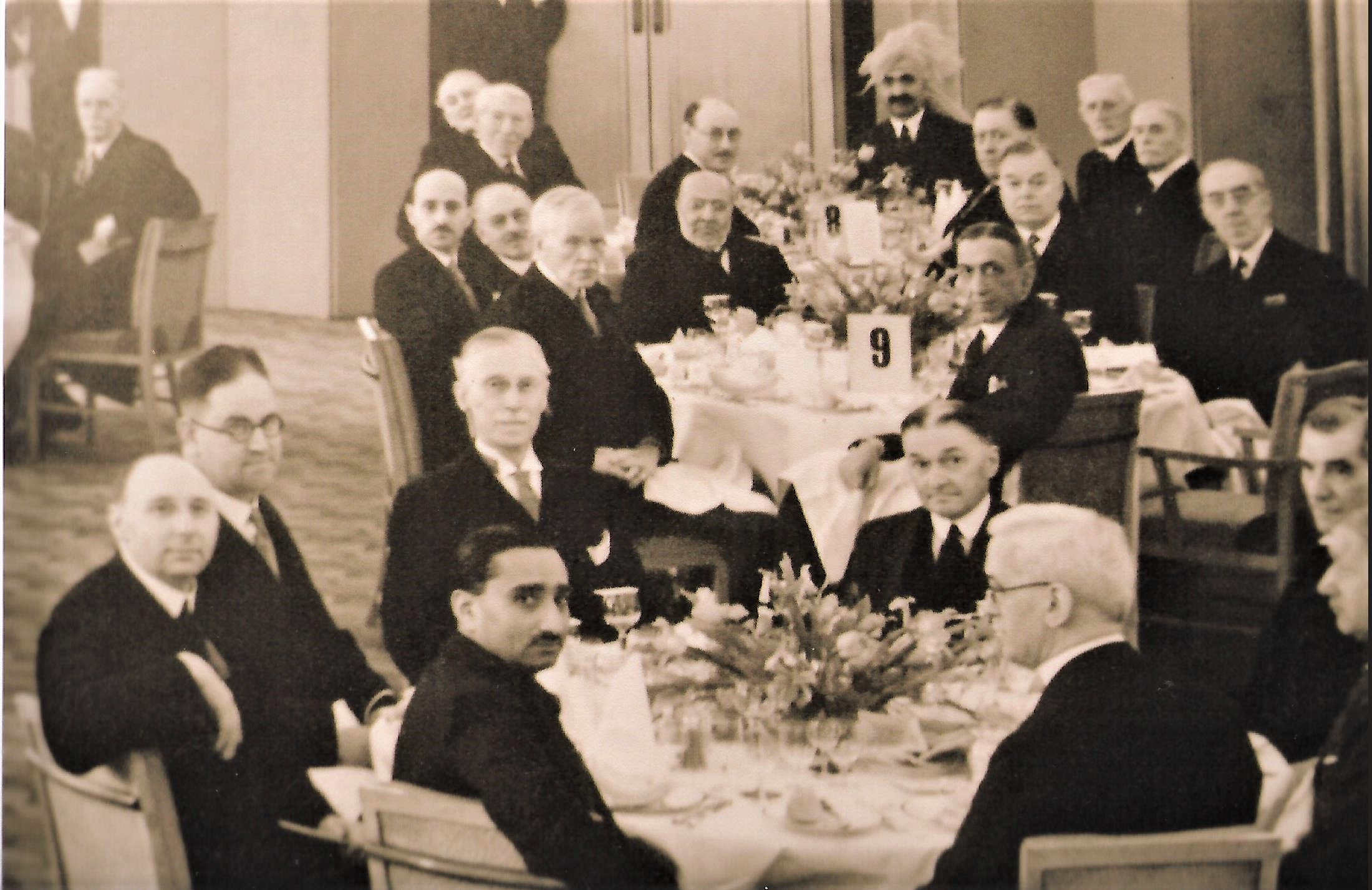
Sir Samad at a dinner during the Second Round Table Conference in London, 1931. He is seated on Table 9 next to the table number.
The next year there was a big family event: the marriage of Sir Samad’s second daughter Fakhra to her cousin Sahabzada Masuduzzafar. Nawab Raza Ali was a good friend of Masud and made all the arrangements for the bridegroom. The marriage was a grand affair with nothing less than six pre-wedding ceremonies that went on for several days. Planning commenced months in advance, and the embroidery and stitching of the dresses took place over a few years.
Sir Samad’s last visit to the UK was in 1936 to attend the coronation of King George VI and to admit his son Yusuf into the Pembroke College, Cambridge. In the large amount of correspondence that was waiting for him on his return was a letter from Maharaja Hari Singh, inviting him to join his cabinet in Kashmir. Sir Samad was touched by the high regard in which the Maharaja held him. It was difficult for him to break the link with the State of Rampur, which he had served for over 40 years, but after some reflection, he accepted the portfolio of home minister. Jammu-Kashmir was one of the larger states and more challenging. He was replaced by B H Zaidi who took over as the chief minister of Rampur. Sir Samad succeeded Mirza Sir Zafar Ali as home minister and worked under Prime Minister Sir Narasimha Gopalaswami. The prime minister was from the ICS cadre, and later served as the second defence minister of independent India.

Sir Samad (1) at a dinner during the Second Round Table in 1931. Standing on the right is Sir Agha Khan (2).
These were difficult times for the princely states. In an environment in which the British dominance was increasingly challenged by Indian politicians, the states were attempting to lead their subjects on the first halting steps towards modernity. The autobiography of Maharaja Hari Singh contains a letter that he wrote in 1952 to Dr Rajendra Prasad, the president of India, in which apart from other things he mentions the measures he took for the efficient administration of the state. He writes that he had the assistance of men of unquestionable integrity from British India, including the former prime minister Colonel K N Haksar from the Gwalior State, who was a delegate at the First Round Table Conference; Sir Narasimha Gopalaswami from Tamil Nadu; Sir Samad; and one of the seven members of the committee that drafted the Indian Constitution.
Sir Samad lived in a beautiful bungalow in Srinagar that resembled a stately manor of the Tudor period. He was accompanied by his household staff, and during the four years he served there, his family enjoyed the beautiful sights of Kashmir in summer while coming back to Rampur for the winter. During the last months of 1939, his youngest son Yaqub was commissioned from the military academy and arrived in Rawalpindi where his regiment had assembled before departing for North Africa. Sir Samad motored down to bid farewell to his youngest son. Yaqub was devoted to his father and emulated him in dress and style, but sadly this was the last time he saw Sir Samad.
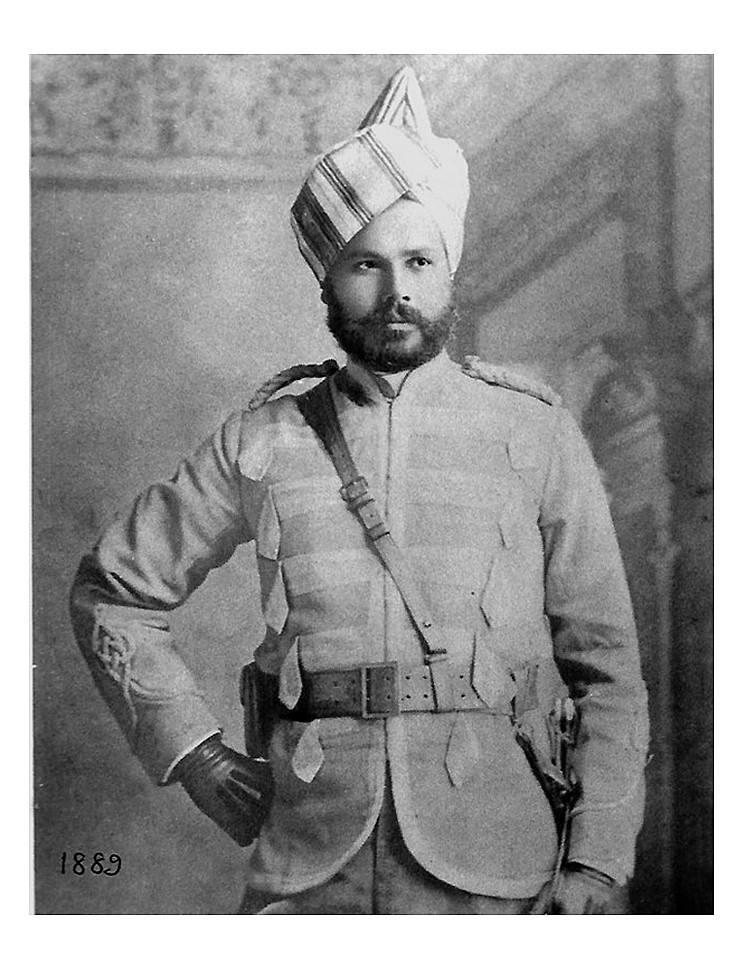
General Azim Uddin Khan (1854-1891), C-in-C Rampur State Forces and Vice President of Rampur Regency Council. He was the uncle and father-in-law of Sir Samad.
After the Second World War broke out, Sir Samad found it difficult to remain in Kashmir. He was too far from Rampur and the schedule of passenger trains was badly disrupted because of military traffic. He resigned from his post in 1941 and returned to Rampur where his youngest daughter Jahanara was married a year later. It was a timely move back home because Sir Samad became very ill by the time of the marriage, and Nawab Raza Ali made all the preparations for the ceremonies.
The news of the capture of Yaqub in North Africa in May 1942 caused great concern to an already ailing father. He survived to see Jahanara wed and passed away a month and a half after the wedding on 27 January 1943, probably due to a heart attack. He was only 64 years old.
Sir Samad’s son Yusuf left his post as a professor at the Aligarh University and shifted to Rampur to take care of his mother and the estate. Nawab Raza Ali appointed him as cabinet secretary to the state government. Yaqub was a prisoner of war first in Italy and then Germany. He was finally repatriated through London and made it a point to stay at the Dorchester Hotel. His father would have approved as also the faithful valet Nathu Singh.
Author’s Note: This article would not have been possible without the immense support in way of family history and photographs generously provided by Sir Samad’s grandson Arif Khan. I also wish to extend my appreciation to Muneeza Shamsie, a granddaughter of Sir Samad for contributing to the compilation of this essay. I found valuable information in the book Remembrance of Days Past by her mother Jahanara Habibullah.
The author is a retired Pakistan Army major general and a military historian. He can be contacted at syedali4955@gmail.com
